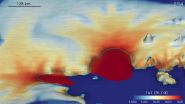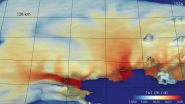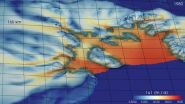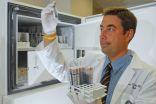(Press-News.org) A new international study is the first to use a high-resolution, large-scale computer model to estimate how much ice the West Antarctic Ice Sheet could lose over the next couple of centuries, and how much that could add to sea-level rise. The results paint a clearer picture of West Antarctica's future than was previously possible. The study is published today (18 August) in The Cryosphere, an open access journal of the European Geosciences Union (EGU).
"The IPCC's [Intergovernmental Panel on Climate Change] 4th and 5th Assessment Reports both note that the acceleration of West Antarctic ice streams in response to ocean warming could result in a major contribution to sea-level rise, but that models were unable to satisfactorily quantify that response," says Stephen Cornford, a research assistant at the University of Bristol, UK and lead-author of the study.
"The novel aspect of our work is the use of a high-resolution ice-sheet model over a larger area and longer time-scale than previously attempted. Much like a higher-resolution digital camera transforms a blur into a flock of birds, higher resolution in a computer model often helps to capture details of the physics involved which may be crucial to the broad picture," says co-author Dan Martin from the Lawrence Berkeley National Laboratory in California, US.
West Antarctica is one of the fastest warming regions on Earth and its ice sheet has been stage to dramatic thinning in recent years. The West Antarctic Ice Sheet (WAIS) is out of balance because it is losing significant amounts of ice to the ocean, with the losses not being offset by snowfall. The lost ice, drained by the ice sheet's several ice streams, amounts to a significant contribution to sea-level rise, which is expected to increase in the future.
Cornford, Martin, and a team of researchers from around the world have now estimated how much the WAIS could contribute to global sea-level rise over the next couple of centuries. Their high-resolution, computationally demanding simulations capture future changes in West Antarctica with increased accuracy compared to previous models. The results reflect uncertainty in future greenhouse gas emissions, snowfall and ocean circulation, but the choice of a high-resolution model allowed the researchers to reduce the numerical error that often plagues ice-flow models.
"We expect future change in the West Antarctic Ice Sheet to be dominated by thinning in the Amundsen Sea Embayment, just as it is today, until at least the 22nd century. But other regions of West Antarctica could thin to a similar extent if the ocean warms sufficiently," explains Cornford.
In their most extreme simulation, where the ice shelves progressively disintegrate over the next century, most of the major ice streams retreat by hundreds of kilometres. The WAIS as a whole would contribute some 80,000 cubic kilometres of lost ice to sea-level rise by 2100 and 200,000 cubic kilometres by 2200. This corresponds to a 20 cm increase in global sea level by the end of this century - sufficient to fill the Caspian Sea - and close to 50 cm by 2200. While these amounts would be enough to threaten low-lying cities and countries, the researchers point out this is an extreme scenario.
"There are many climate processes lying between the direct consequences of greenhouse-gas emissions and the regional ocean warming used as forcing in the modelling reported in The Cryosphere, many of which are poorly understood," explains co-author Tony Payne, a professor at the University of Bristol. "It would therefore be premature to attach a likelihood to any particular retreat scenario; however it is useful to quantify the magnitude of sea-level rise in some of these more extreme cases."
The researchers wanted to find out how the ice sheet would respond to both modest and extreme future warming. "We subjected an ice dynamics model to a range of ocean and atmospheric changes, ranging from no change at all, through the future changes projected by state-of-the-art ocean and atmosphere models, to extreme changes intended to study the upper reaches of future sea-level rise," explains Cornford.
"The research involved many different steps as the results of global climate models were fed into regional models of the Antarctic atmosphere and ocean, whose results were in turn used to force the ice-sheet model in this study," Payne adds.
This comprehensive high-resolution study is a significant improvement from previous calculations, which were lower in resolution or scale, allowing researchers to make more accurate predictions about West Antarctica's future.
INFORMATION:
Please mention the name of the publication (The Cryosphere) if reporting on this story and, if reporting online, include a link to the paper (TBA) or to the journal website.
Images, videos and pre-print of the paper available at: https://www.egu.eu/news/188/most-comprehensive-projections-for-west-antarcticas-future-revealed/
A group of clinicians and geochemists are working to develop a test for the most common form of primary liver cancer, HCC (Hepatocellular Carcinoma). HCC kills over 600,000 people worldwide every year. It usually develops from chronic liver disease such as hepatitis or cirrhosis, but there is no good biochemical test to indicate when the cancer develops, meaning that even for patients most at risk, it is nearly impossible to know when a cancer may develop until symptoms appear. Now a multi-national group of scientists are developing a new test for HCC, based on methods ...
COLUMBUS, Ohio - Employees with a racially diverse group of friends outside of work may actually perform better at their jobs, a new study suggests.
Researchers found that workers who had more different-race friends in their personal lives than their co-workers also tended to have a more racially diverse network of friends on the job. This broader network was linked to employees who did more tasks beyond their job responsibilities and who, under certain circumstances, had more trust in their supervisors.
"Your friends outside of work actually have this connection to ...
This news release is available in French. This news release is available in French. New research shows that teaching young adolescents practical cooking skills leads to positive changes for the entire family. In an article published today in Applied Physiology, Nutrition, and Metabolism, an NRC Research Press journal (a division of Canadian Science Publishing), researchers evaluated the Kinect-Ed presentation and found an increase in the frequency of family dinners after participation.
Kinect-Ed, a 90-minute motivational nutrition education presentation, was ...
BOSTON, Aug. 18, 2015 -- Cranberries are often touted as a way to protect against urinary tract infections, but that may be just the beginning. Researchers fed cranberry extracts to mice with colon cancer and found that the tumors diminished in size and number. Identifying the therapeutic molecules in the tart fruit could lead to a better understanding of its anti-cancer potential, they say.
The team will describe their approach in one of more than 9,000 presentations at the 250th National Meeting & Exposition of the American Chemical Society (ACS), the world's largest ...
BOSTON, Aug. 18, 2015 -- The use of solar energy in the U.S. is growing, but panels on rooftops are still a rare sight. They cost thousands of dollars, and homeowners don't recoup costs for years even in the sunniest or best-subsidized locales. But scientists may have a solution. They report today the development of a unique, "green" antenna that could potentially double the efficiencies of certain kinds of solar cells and make them more affordable.
The researchers are presenting their work at the 250th National Meeting & Exposition of the American Chemical Society (ACS). ...
INDIANAPOLIS -- People being treated for bipolar disorder and other psychiatric illnesses are at greater risk of attempting suicide, but physicians may now have tools to predict which of those individuals will attempt it and intervene early to prevent such tragedies from occurring.
Researchers at Indiana University School of Medicine reported Tuesday in the Nature Publishing Group's leading journal in psychiatry, Molecular Psychiatry, that they have developed blood tests and questionnaire instruments that can predict with more than 90 percent accuracy which of those patients ...
An unprecedented potential "molecular tweezer" called CLR01, reported in the journal eLife, not only blocks HIV and other sexually transmitted viruses, but also breaks up proteins in semen that boost infection.
Semen is the main vector for sexual HIV transmission. It contains proteins that assemble into very stable polymers called amyloid fibrils, which can enhance HIV infectivity by up to 10,000 times. Scientists led by the University of Pennsylvania (USA) and Ulm (Germany) now show that a molecule with the shape of a tweezer not only destroys HIV particles but also ...
A new study shown that meteorite impacts on ancient oceans may have created nucleobases and amino acids. Researchers from Tohoku University, National Institute for Materials Science and Hiroshima University discovered this after conducting impact experiments simulating a meteorite hitting an ancient ocean (Fig. 1).
With precise analysis of the products recovered after impacts, the team found the formation of nucleobases and amino acids from inorganic compounds. The research is reported this week in the journal Earth and Planetary Science Letters.
All the genetic information ...
Children with better academic and behavioral functioning when they start kindergarten often have better educational and societal opportunities as they grow up. For instance, children entering kindergarten with higher reading and math achievement are more likely to go to college, own homes, be married, and live in higher-income neighborhoods as adults. Now a new study points to very early roots of differences in school readiness, with growth in vocabulary playing a particularly important role. The study found that children with larger oral vocabularies by age 2 arrived at ...
Adolescents who have romantic relationships tend to have more problems with psychosocial adjustment. In contrast, young adults who have romantic relationships tend to have fewer problems with psychosocial adjustment. Although the links between having a romantic relationship and psychosocial adjustment change with age, a new longitudinal study has found that it's not just having a relationship that matters, but the quality of the relationship: Higher-quality romantic relationships are associated with fewer psychosocial difficulties across adolescence and young adulthood.
The ...




